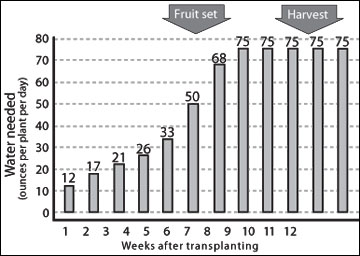Author: Natalie Hoidal, UMN Extension educator, local foods and vegetable crops
This week has brought some welcome respite from the heat and humidity, but drought conditions have persisted across much of the state. Crops seem to be responding well to the lower temperatures this week, with a few exciting new crops reaching maturity. As we shift into late summer, keep your eyes out for some important late summer insect pests.
Problems in the field / things to note this week
Are your plants getting enough water?
 |
| Water requirements of high tunnel tomatoes from Lewis Jett, University of Missouri |
Drought update
I've spoken to a few growers this week who claim that the drought is worse this year than it was last year, so I thought I'd take some time to do a drought update again this week. The entire middle of the state is abnormally dry, while only a pocket around the Twin Cities is in severe drought, with a ring around the cities from Stillwater to Willmar in a moderate drought. That said, most crops are in their critical periods, where access to consistent water is critical for healthy fruit, root, and river set, and at this stage in the summer crops are larger and using more water than they would have been in June 2021, which is a drought reference point in our recent memories. While a pocket of growers in Central Minnesota received over an inch of rain in the storms on Tuesday night, most of the state received very little rainfall, and it didn’t appear to be enough rain to lessen the drought diagnosis. Check out the map here.
An abundance of worms
Crop updates
- Tomatoes and peppers: Field grown cherry tomatoes are beginning to make appearances on many farms in south and central Minnesota. I'm seeing quite a few photos of tomatoes with scars, zippering, and catfacing, particularly from tunnels. These issues are due to a combination of high heat, fast growth, and poor pollination. Pepper harvest is ramping up; we are beginning to harvest serranos and jalapenos in our hot pepper trials.
- Garlic: Many growers have started harvesting garlic. So far the crop this year looks good, with limited aster yellows and disease pressure. Wondering if you're ready to harvest? There are two main ways to determine whether your garlic is ready: when about half of the leaves turn brown is a fairly reliable indicator of maturity. You can also harvest a few bulbs and cut them in half. If the cloves fill the skin, they are ready.
- Cole crops: During the last two summers we've been trying to screen broccoli for disease tolerance, but it's become more of a heat tolerance trial based on the weather we've had. We continue to see varietal differences in various heat related traits, and we're excited to share our full results this fall. I've heard from a few growers this week that flea beetle damage remains extremely high in certain pockets of the state, while many growers have not had many issues at all this year. In case you are still struggling with flea beetles, here's a quick review article of management strategies.
- Carrots: I continue to get questions about aster leafhopper, but so far populations are low.
- Onions: Onions are starting to reliably mature. Some growers are seeing smaller than usual onions. Since onions have such shallow roots they can be quite susceptible to fluctuating water levels and drought, so this is likely the reason for smaller onions this year. Despite the hot summer I have not seen many onion thrips yet during farm visits, but growers should continue to scout for them.
- Cucurbits: We received more reports of squash vine borer activity this week. If this insect has not yet been on your radar, make some time to scout your fields this week, as we are at the point in the summer where larvae start to do significant damage to stems. Melons, pumpkins, and winter squash are beginning to set fruit more reliably.
- Sweet corn:
Sweet corn was coming in more reliably this week compared to last week, at least for the growers that I talked to. European corn borers were just starting to show up in traps last week in Southern Minnesota, and degree day models suggest that
we'll see more moths and egg laying this week. Corn tassling is catching up across the state, but continue to keep a close eye on peppers, particularly those in high tunnels.

Comments
Post a Comment